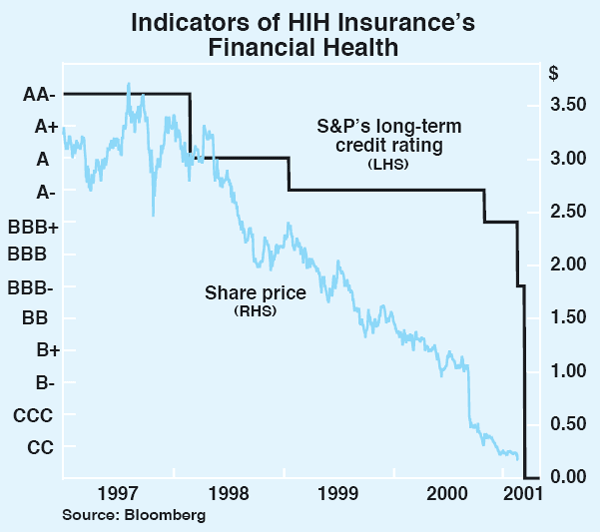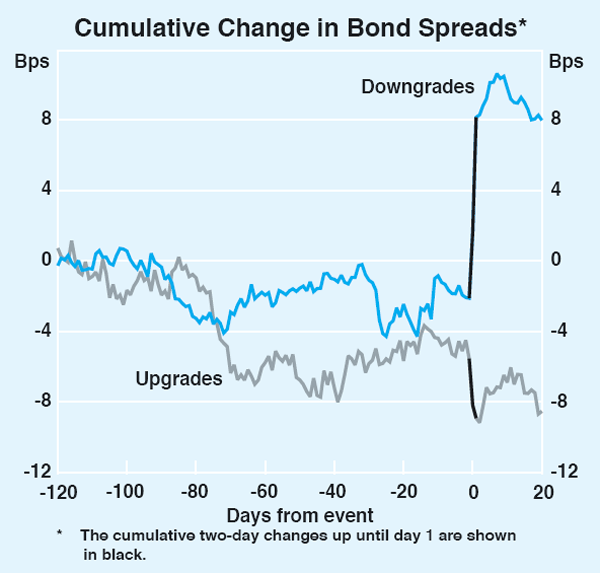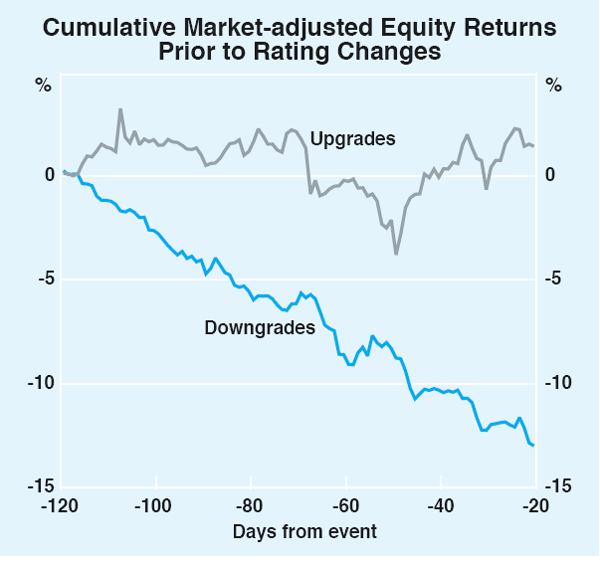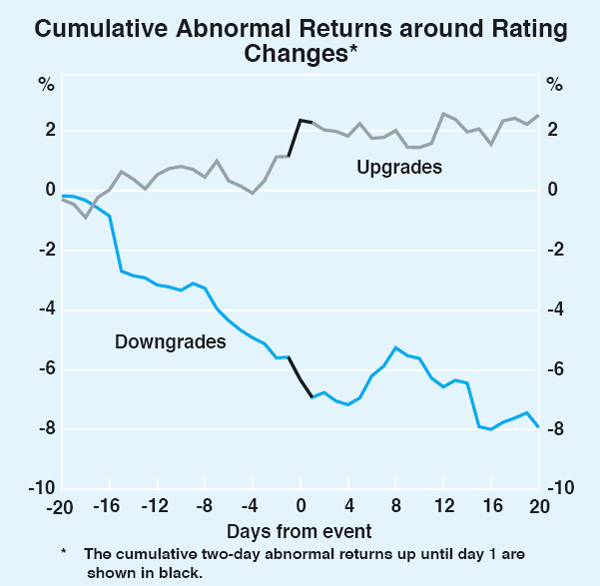Bulletin – April 2004 Credit Ratings and Market Dynamics[1]
- Download 68KB
Introduction
Rating agencies provide opinions on the creditworthiness of companies and debt instruments, and so reduce lenders' information gathering costs. Their ratings are especially useful in distinguishing the relative riskiness of different borrowers. Empirical evidence suggests that rating agencies rank the riskiness of borrowers well: realised default rates are consistently higher for lower rating grades.
Over the past few years, however, the performance of rating agencies has been widely debated. Concerns have been expressed about the timeliness and predictive accuracy of ratings – issues that have received greater attention internationally following the high-profile collapses of Enron and WorldCom in the United States. Similar scenarios have arisen in Australia too: HIH Insurance had an investment-grade rating only a few weeks before it became insolvent (Graph 1). Such concerns have prompted some observers to question the value of the rating agencies, and to suggest that their opinions do not contain information beyond what is already available to debt and equity market participants. This is a proposition that can be tested by examining how changes in ratings affect financial market prices. Such tests also shed light on rating agencies' contribution to the dynamics of market pricing. This article presents evidence on the response of security prices to credit rating changes in Australia.

Response of Australian Debt and Equity Prices to Rating Changes
The response of financial markets to rating changes can be analysed by looking at how Australian equity and bond prices behave around the time of changes in ratings by Moody's and Standard and Poor's, the two largest agencies in the Australian market.[2] The study summarised in this article covers changes in credit ratings between January 1990 and July 2003. Rating changes commonly occur on the same day as other relevant news. To avoid difficulties in interpreting market price movements, the sample is limited to those rating changes that are not accompanied by other value-relevant announcements, concerning issues such as earnings, mergers or divestments. These exclusions ensure that only the impact of the rating change itself is captured. For this study, rating changes include both discrete movements along the rating scale, and ‘watch’ announcements, whereby a rating agency indicates that it is considering a near-term change in a firm's rating in an indicated direction. Since it is difficult to obtain reliable daily data for bond pricing, there are substantially fewer sample rating changes with accompanying bond price data than with equity price data.[3]
Bonds
For bonds, the reaction to rating announcements was studied by examining the daily spread between the yields on individual corporate bonds and the yields on Commonwealth Government bonds of similar maturity. Bond spreads adjust noticeably in response to credit rating changes, particularly in comparison to the movements over the previous 100 days. On average, the spreads of upgraded bonds narrow by around 3.5 basis points over the day of the announcement and the following day (Graph 2). Downgraded bonds show substantially more response; their spreads rise by over 10 basis points in the same two-day period. There is little evidence of significant movements in spreads in the few weeks prior to or after a rating change, which might have been expected if markets partly anticipate the news provided in rating changes.

For both groups of bonds there is a discernible but gradual decline in spreads of about 4 basis points over the 100 days leading up to the rating change. This most likely reflects the general pattern of lower spreads for shorter-maturity bonds.
The median two-day sample response to a rating change, across both upgraded and downgraded bonds, is 4.5 basis points; and the median rating change is between A and A−. Looking at a much larger group of Australian bonds, the typical yield differential between A rated and A− rated bonds is about 9 basis points; so it seems that around half of the expected long-term adjustment in bond spreads takes place in the two days around the rating change.
Equities
One way of testing the response of equity prices is to compare how returns on upgraded or downgraded companies differ from the return performance of the overall equity market, as measured by the All Ordinaries Index. A simple measure of relative performance over a long period of time is provided by cumulative market-adjusted returns, which are simply the differences between cumulative equity returns for individual companies and the cumulative return on the All Ordinaries Index. In the case of downgraded equities, this measure indicates that prices have already fallen significantly prior to the rating change period (Graph 3).

When considering the performance of companies immediately around events such as rating changes, researchers usually calculate measures of ‘abnormal’ equity returns. These represent an estimate of how equity prices might have been expected to behave based on their usual relationship with an overall market index. Once the latter relationship has been estimated, the daily abnormal returns for equity prices in the vicinity of rating changes can be summed to show their behaviour over time. Positive abnormal returns mean that a particular stock performed better than might have been expected.
Estimates of cumulative average abnormal returns indicate that – as was the case for bonds – equity prices show a clear response to rating changes, rising after upgrades and falling after downgrades (Graph 4). These results accord with expectations. Upgrades are associated with abnormal returns of around 1 per cent on the announcement day. Downgrades are associated with negative abnormal returns of a little over 1 per cent, although this is spread evenly over the day of the announcement and the subsequent trading day. Downgraded equities also underperform in the 20 days prior to the rating change, implying that negative news contained in rating announcements is already factored into prices. For upgrades and downgrades, abnormal returns in the four weeks after rating announcements indicate little evidence of ongoing adjustment.

Summing together the price movements illustrated in Graphs 3 and 4, the results suggest that the equity prices of subsequently downgraded firms decline (relative to the performance of the All Ordinaries Index) by almost 20 per cent in the 120 days leading up to the ratings downgrade. In contrast, the returns of subsequently upgraded firms are little different to the returns on the overall market.
Financial markets appear to attach particular significance to rating changes that carry companies from investment to sub-investment grade.[4] This could be because fund managers often face restrictions that derive from investors' mandates on the types of investments they can hold, which often hinge on the investment grade distinction. Moreover, crossing this ‘threshold’ can have important psychological effects. The seven instances in this sample of firms being downgraded below this threshold result in relatively large average abnormal returns of −3.2 per cent on the two days around the downgrade. In addition, there is a −15 per cent underperformance in the 20 days leading up to the downgrade, compared with only −5 per cent for non-threshold downgrades. This would be consistent with agencies being very cautious about downgrading companies through the barrier, and only doing so when there is very clear negative information about those firms.
Conclusion
Credit rating changes result in noticeable price movements for both equities and bonds; this suggests that rating agencies perform a useful function in financial markets by providing information about creditworthiness that, at the margin, financial markets consider of value. Nevertheless, the price impacts associated with rating announcements are fairly small, which implies that agencies are not generally viewed as consistently having access to important information that is not already in the public domain.
Looking ahead, if ratings become more widely used in debt contracts – for example, through ratings ‘triggers’ which call for higher interest rates, provisions of more collateral, or even the repayment of the debt – then the decisions of agencies might have a greater impact on market prices. However, in 2002 only around 15 per cent of large Australian firms had ratings triggers built into their borrowing agreements and also had ratings near enough to these triggers to warrant concern that they could be subject to potentially destabilising rating downgrades.[5] Hence, these provisions are unlikely to have had substantial impacts on the Australian market in the period examined in this study.
Furthermore, in a regulatory regime where ratings have some role in regulatory bank capital adequacy requirements, it is possible that the decisions of agencies could affect market valuations because they impact more directly on the cost of funds. The new Basel Capital Accord will allow banks to use agencies' ratings (or their own internal ratings) when determining the amount of capital to be held against particular types of loans. These regulatory arrangements, and the fact that increasingly banks are benchmarking their own credit risk assessments against ratings from the agencies, may strengthen the influence of ratings on banks' willingness to lend. Taken together, these two factors suggest the potential for credit ratings to have a greater impact on market prices than has been seen over the past decade.
Footnotes
This article was prepared by Adam Creighton of System Stability Department. It summarises the results of research undertaken with Luke Gower and Anthony Richards that was published in RBA Research Discussion Paper No 2004-02, entitled ‘The Impact of Rating Changes in Australian Financial Markets’. Staff research published by the Bank is intended to contribute to debate, and does not necessarily reflect the views of the Bank. [1]
In Australia, Moody's and Standard and Poor's rate over 500 issuers, which account for more than 90 per cent of the outstanding stock of bonds. Fitch Ratings is the third-largest agency. [2]
The bonds in question are all issued in Australia and denominated in Australian dollars. [3]
Investment-grade ratings are those equal to or better than BBB–/Baa3. [4]
Standard & Poor's (2002), ‘Ratings Triggers and Credit Cliffs – Are Australian and New Zealand Companies at Risk?’. [5]